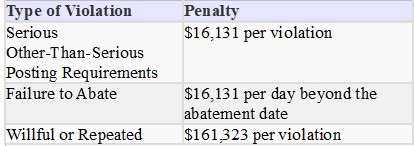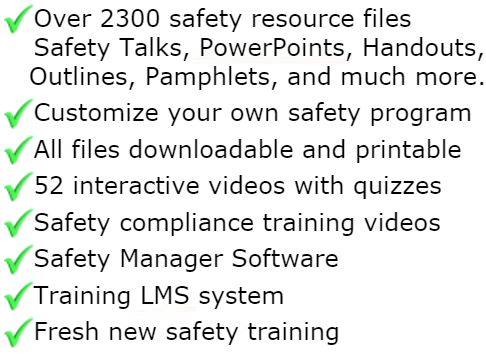
Safety Training PowerPoint Presentations
Designed for employee safety training - covers essential information for employee safety training. Fully customizable for specific workplace environments. Use these Safety PowerPoints in conjunction with other safety training material in the safety library.
Training Requirements For OSHA General Industry Standards?
Employee Emergency Plans and Fire Prevention Plans (1910.38)
(a.5.i) Designate and train a sufficient number of persons to assist in emergency evacuation of employees.
(a.5.ii) Review the plan with covered employees: (A) when the plan is developed; (B) whenever the employee's responsibilities change; and (C) whenever the plan is changed.(a.5.iii) Review with employees upon initial assignment parts of the plan employees must know in the event of an emergency. The written plan must be kept at the workplace and made available to employees. Employers with ten or fewer employees may communicate the plan orally.
(b.4.i) Apprise employees of the fire hazards to which they are exposed.
(b.4.ii) See (a.5.iii).
Powered Platforms for Building Maintenance (1910.66)
(i.1.i) Only persons proficient in operation of a particular platform can operate a working platform.
(i.1.ii.) Employees operating working platforms must be trained in recognizing and preventing safety hazards, and knowing emergency action plans, work procedures and how to take care of personal fall arrest systems.
(i.1.iii) A competent person must perform training.
(i.1.iv) Provide written work procedures for employee training.
(i.1.v) Certify employee training.
Ventilation (1910.94)
(d.9.i) Employees working in and around open surface tanks must be instructed about hazards in their jobs.
(d.9.vi) Train employees using respirators in an emergency.
(d.11.v) A trained standby must be present when someone enters a tank containing a hazardous atmosphere.
Occupational Noise Exposure (1910.95)
(i.4) Provide training in the use and care of all hearing protectors.
(k.1) Institute a training program for all employees exposed to noise at or above an eight-hour time-weighted average (TWA) of 85 decibels (dB), and ensure that every em-ployee participates.
(k.2) Repeat training program annually for employees included in the hearing conservation program. Update information in the program to keep it consistent.
(k.3) Ensure employees are informed of the following: (i) effects of noise on hearing; (ii) purpose of hearing protectors, the advantages, disadvantages and attenuation of various types, and instruction on selection, fitting, use and care; and (iii) purpose of audiometric testing, and an explanation of the test procedures.
Flammable & Combustible Liquids (1910.106)
(b.5.vi.V.2) Post detailed flood emergency instructions.
(b.5.vi.V.3) Inform station operators who carry out flood instructions of valve location.
Explosives & Blasting Agents (1910.109)
(d.3.i) Drivers of explosives carriers must be familiar with traffic regulations.
(d.3.iii) Attendants to drivers must be aware of materials in the truck and what measures to take to protect the public from dangers.
(g.3.iii.A) Operators of bulk delivery vehicles carrying blasting agents must be trained in safe operations of the vehicle and the material being delivered.
(g.6.ii) Drivers of vehicles carrying packaged blasting agents must be familiar with vehicle and traffic laws.
(h.4.ii.B) Operators of water gel bulk delivery and mixing vehicles must be trained in safe operations of the vehicle and its related equipment.
Storage and Handling of Liquified Petroleum Gases (1910.110)
(b.16) Train personnel performing installation, removal, operation and maintenance work.
Storage & Handling of Anhydrous Ammonia (1910.111)
(b.13.ii) Instruct personnel unloading tank cars.
Process Safety Management of Highly Hazardous Chemicals (1910.119)
(g.1) Initially train all employees involved in a process and newly assigned to a process as specified in paragraph (f) of the standard.
(g.2) Provide refresher training at least every three years, and more often if necessary, for all employees operating a process.
(g.3) Document training kept and include the identity of the employee, the date of training and the means used to verify that the employee understood the training.
(h.3.i) Contract employers must assure employees are trained in safe work practices.(h.3.ii) Contract employers must instruct employees about potential hazards of his/her job and know the emergency action plan.
(h.3.iii) Contract employers must document training and prepare a record identifying the employee.
(j.3) Employees involved in maintaining the on-going integrity of process equipment must be trained in an overview of the process and it hazards, and in the procedures necessary for that employee to perform the job safely.
Hazardous Waste Operations and Emergency Response (1910.120)
(e.1.i) Train employees exposed to any hazardous situations before they engage in operations.
(e.2) Training must cover the following: (i) names of personnel and alternates responsible for site safety and health; (ii) safety and health hazards present on the site; (iii) use of personal protective equipment; (iv) work practices that minimize risks; (v) safe use of equipment; (vi) medical surveillance requirements; and (vii) contents of paragraph G-J of plan set forth in paragraph (b.4.ii) of this section.
(e.3.i) General site workers engaging in any hazardous activity must receive 40 hours of off-site instruction and a minimum of three days supervised field experience.
(e.3.ii) Workers on-site occasionally must receive 24 hours of off-site instruction and one day of supervised field experience.
(e.3.iii) Workers who work in non-hazardous areas must receive 24 hours of off-site instruction and one day of supervised field experience.
(e.3.iv) Workers in (3.ii) and (3.iii) must receive 16 additional training hours when they become general site workers.
(e.4) Supervisors responsible for employees engaging in hazardous operations must receive 40 hours initial training.
(e.5) Trainers must complete a training program.
(e.6) All trained employees and supervisors must be given a written training certificate.(e.7) Train emergency response employees to respond to such expected emergencies.(e.8) Employees specified in paragraphs (e.1) and (e.4) must receive eight hours of refresher training annually.
(e.9) Employers who can document an employee's work experience equals training required in (e.1)-(e.4) of this section do not have to provide initial training requirements.(o.1) Develop and implement procedures for the introduction of effective new technologies and equipment used to protect employees working with hazardous waste clean-up operations.
(p.7.i) Develop a training program with 24 hours of refresher training for employees exposed to health hazards.
(p.7.ii) Refer to (e.9).
(p.7.iii) Trainers must complete a training course or have academic credentials.
(p.8.iii) Refer to (e.7).
(q.4) Temporary skilled support personnel do not need training.
(q.5) Specialist employees must prove their competency in their specialization annually.(q.6) Train emergency response employees in the following: (i) first responder awareness level; (ii) first responder operations level; (iii) hazardous materials technician; (iv) hazardous materials specialists; and (v) on-scene incident com-mander.
(q.7) Refer to (p.7.iii).
(q.8) Employees trained in (q.6) must receive annual refresher training.
For a complete summary of the standard and related training requirements, see Chapter 10, "Hazardous Materials Handling," in Volume II of this Directory or the OSHA standard 1910.120.
General Requirements of Personal Protective Equipment (1910.132)
(f.1) Train employees using PPE in the following: (i) when and what PPE is necessary for the workplace; (ii) how to put on, remove, adjust and wear the PPE; and (iii) the limitations, proper care, maintenance, life expectancy and disposal of the PPE.
(f.2) Employees must demonstrate that they understood their training prior to performing work.
(f.3) Retrain employees when: (i and ii) changes occur in the workplace or types of PPE; and (iii) inadequacies exist in the employee's knowledge of PPE.
(f.4) Verify employee training with a certificate.
(b.13.ii) Instruct personnel unloading tank cars.
Respiratory Protection (1910.134)
(k)(1)(i) Why the respirator is necessary and how improper fit, usage, or maintenance can compromise the protective effect of the respirator;
(k)(1)(ii) What the limitations and capabilities of the respirator are;
(k)(1)(iii) How to use the respirator effectively in emergency situations, including situations in which the respirator malfunctions;
(k)(1)(iv) How to inspect, put on and remove, use, and check the seals of the respirator;(k)(1)(v) What the procedures are for maintenance and storage of the respirator;
(k)(1)(vi) How to recognize medical signs and symptoms that may limit or prevent the effective use of respirators; and
(k)(1)(vii) The general requirements of this [the OSHA standards] section.
Temporary Labor Camps (1910.142)
(k.2) First aid facilities must be run by a person trained to administer first aid.
Accident Prevention Signs & Tags (1910.145)
(c.l.ii) Employees must be instructed that danger signs indicate immediate danger.
(c.2.ii) Employees must be instructed that caution signs indicate a possible hazard.
Permit-Required Confined Spaces (1910.146)
(g.1) Train employees on the knowledge and skills necessary for safe performance in this area.
(g.2) Training must be given to affected employees: (i) before their first assigned duties; (ii) before there is a change in assigned duties; (iii) whenever a change in permit space operations causes a hazard that an employee has not previously been trained on; and (iv) whenever the employer believes there are deviations from the procedures in (d.3) of this section.
(g.3) Training must establish employee proficiency and introduce new or revised procedures when necessary.
(g.4) Certify employee training.
The Control of Hazardous Energy (Lockout/Tagout) (1910.147)
(a.3.ii) When other standards in this part require lockout/tagout, they must be used and supplemented by procedural and training requirements.
(c.4.i) Develop procedures for control of hazardous energy.
(c.6.i.C) Periodic inspection of tagout used for energy control must include a review between the inspector and au-thor-ized employees.
(c.7.i) Training must include: (A) recognizing and controlling applicable hazardous energy sources; (B) purpose and use of energy control procedures; and (C) instruction to employees not affected.
(c.7.ii) Employees must know the following about tags: (A) they are warning devices without physical restraint; (B) they must not remove tags without authorization; (C) tags must be legible and understandable; (D) tag's material must with--stand environmental conditions; (E) tags may evoke a false sense of security; and (F) tags must be securely attached to energy isolating devices.
(c.7.iii) Retrain employees when: (A) a change in job assignments, machines, equipment or processes occurs; (B) periodic inspections reveal inadequacies; and (C) there is a need to reestablish employee proficiency.
(c.7.iv) Certify employee training.
(c.8) Lockout/tagout must be performed only by authorized employees.
Medical Services & First Aid (1910.151)
(b) When medical aid is not nearby, a person or persons must be trained to give first aid.
Fire Brigades (1910.156)
(c.1) Provide training and education for brigade members before they perform emergency activities. Training instructors and fire brigade leaders must receive more comprehensive training.
(c.2) Train, at least annually, brigade members, and quarterly for members expected to perform interior structural fire fighting duties.
(c.3) The training and education program should be similar to programs conducted by fire training schools.
(c.4) Inform fire brigade members about special hazards to which they may be exposed, and changes to specific hazards during emergencies. Employers must provide written procedures.
Portable Fire Extinguisher (1910.157)
(g.1) Provide employees with portable fire extinguishers and an education program on them.
(g.2) Education of (g.1) must be given upon initial em-ploy-ment and annually thereafter.(g.3) Train employees in the use of the appropriate fire fighting equipment.
(g.4) Training in (g.3) must take place upon initial assignment and annually thereafter.
Fixed Extinguishing Systems, General (1910.160)
(b.10) Train personnel designated to inspect, operate or repair these systems and annually review their training.
Servicing Multi-Piece and Single-Piece Rim Wheels (1910.177)
(c.1) Train employees servicing rim wheels. Safety procedures are as follows: (i) employees must not service rim wheels unless trained in the correct procedures; (ii) training must include the applicable data contained in charts and contents of this standards; and (iii) train employees in an understandable manner.
(c.2) Employees must demonstrate the ability to service rims safely, including the following: (i) demounting of tires; (ii) inspection and identification of rim wheel components; (iii) mounting of tires; (iv) use of restraining device or barrier; (v) handling of rim wheels; (vi) inflation of tire when single-piece rim wheel is mounted; (vii) understanding when it's necessary to stand outside the trajectory; and (viii) installation and removal of rim wheels.
(c.3) Evaluate employees' performance of these tasks.
(f) Establish and train employees in safe operating procedures for servicing multi-piece rim wheels. Procedure elements include: (1) deflating and demounting tires by re--moving valve core; (2) deflating tires by removing valve core before rim wheel is removed from the axle in the following: (i) when tire has been driven underinflated at 80% or less of recommended pressure; and (ii) when there is obvious damage to tire or wheel components; (3) apply rubber lubricant to bead and rim mating surfaces; (4) underinflated tires having more than 80% recommended pressure may be inflated while rim wheel is on vehicle, provided remote control inflation equipment is used; (5) inflate tires outside restraining devices only to pressure sufficient to force tire bead onto the rim ledge; (6) do not rest or lean on equipment when a rim wheel is in a restraining device; (7) after tire inflation, inspect the tire and wheel components while still within the restraining device; (8) do not hammer the seating of side and lock rings while tire is pressurized; (9) do not rework or weld damaged rim components; and (10) employees must stay out of trajectory when wheels are handled.
(g) Establish and train employees in safe operating procedures for servicing single-piece rim wheels. Procedure elements include: (1) deflating tires by removing valve core before demounting; (2) mounting and demounting done from narrow ledge side of wheel; (3) before rim wheel assembly, apply nonflammable rubber lubricant to bead and wheel mating surfaces; (4) if using a tire changing machine, inflate tire to minimum pressure necessary to force tire bead onto rim ledge; (5) if using bead expander, remove it before valve core is installed; (6) inflate tires only when contained within a restraining device, positioned behind a barrier or bolted on vehicle; (7) do not inflate tires when a flat, solid surface is within one foot of the sidewall; (8) employees must stay out of trajectory when inflating a tire; (9) do not inflate tires more than inflation pressure stamped in the sidewall; (10) do not inflate tires above manufacturer recommended maximum pressure; (11) do not apply heat; and (12) do not rework or weld any damaged wheels.
Powered Industrial Trucks (1910.178)
(l) Devise methods to train operators in safe operation.
Overhead & Gantry Cranes (1910.179)
(n.3.ix) When two or more cranes are used, a qualified person must be in charge of the operation.
(o.3) Familiarize operators with care and use of the fire extinguisher provided.
Crawler Locomotive & Truck Cranes (1910.180)
(i.5.ii) Operating and maintenance personnel must be made familiar with use and care of the fire extinguisher pro-vided.
Mechanical Power Presses (1910.217)
(e.3) Train maintenance personnel.
(f.2) Train operators in safe methods of work.
(h.13.i) Operator training in (f.2) must include instruction for presses in the presence sensing device initiation (PSDI) mode. Instructions include: (A) manufacturer's test procedures for checking operations; (B) safety distance; (C) operation, function and performance of the PSDI mode; (D) requirements for hand tools; and (E) severe consequences resulting from by-passing any safeguards.
(h.13.ii) Certify employee training.
Forging Machines (1910.218)
(a.2.iii) Train personnel on the inspection and maintenance procedures of this equipment..
Oxygen-Fuel Gas Welding and Cutting (1910.253)
(a.4) Deem employees competent to do their work.
Arc Welding and Cutting (1910.254)
(a.3) Instruct and qualify workmen.
Resistance Welding (1910.255)
(a.3) Instruct workmen and deem them competent.
Pulp, Paper and Paperboard Mills (1910.261)
(h.3.ii) Instruct workers on the use of chlorine absorbing gas masks.
Laundry Machinery & Operations (1910.264)
(d.1.v) Instruct employees on hazards and safe practices of their work.ork.
Pulpwood Logging (1910.266)
(i.1) Train employees and supervisors at no cost.
(i.2) Training must be provided as follows: (i) as soon as possible for current employees and new employees; (ii) before new employees' initial assignment; (iii) when new work or equipment is assigned; and (iv) when employees demonstrate unsafe performance.(i.3) Training must consist of: (i) safe performance of work tasks; (ii) safe use, maintenance and understanding of tools, machines and vehicles; (iii) ability to recognize and prevent hazards within their work; (iv) ability to recognize and prevent hazards in logging industry; (v) procedures, practices and requirements of employer's work site; and (vi) requirements of this standard.
(i.4) Training may be limited to section (i.3) of this section when employees show unsafe performance or new equipment or work is assigned.
(i.5.i) Current employees trained in (i.3) are not required to be retrained in those elements.
(i.5.ii) New employees trained in (i.3) are not required to be retrained in those elements before initial assignment.
(i.5.iii) Train all employees in elements for which they have not received training.
(i.5.iv) Ensure all employees can properly and safely perform their duties.
(i.6) Each new employer and employees trained under (i.2) must work under supervision of a designated person until employees demonstrate the ability to perform their new duties alone.
(i.7.i) Each employee and supervisor must receive first aid and CPR training.
(i.7.ii) Employees' first aid and CPR certification must remain current.
(i.8) A designated person must conduct training.
(i.9) Training must be easily understandable.
(i.10) Certify employee training.
Telecommunications (1910.268)
(b.2) Teach employees emergency procedures for working with storage batteries.
(c) Train employees on safe practices before they start work. Training must include: (1) recognizing and avoiding dangers; (2) emergency procedures; and (3) first aid and CPR training.
(j.4.iv.D) Derrick operators must be trained.
(l.1) Train employees exposed to high voltages.
(o.1.ii) A person with first aid training must be readily available during manhole work.(o.3) A person with first aid training must be readily available when the manhole worked on is occupied by an electric and telecommunications utility.
(q.1.ii) Employees engaged in line-clearing operations must be instructed that: (A) direct contact is made when the body touches energized electrical fixtures; (B) indirect contact is made when the body touches an object that is in contact with energized fixtures; (C) indirect contact can be made through conductive tools, tree branches or other objects; and (D) electrical shock occurs when there's direct or indirect contact with any energized conductor.
(q.2.ii) Only qualified employees or trainees can perform work when electrical hazards exist.
(q.2.iii) A second qualified employee must be present during tree working operations.
Grain Handling Facilities (1910.272)
(e.1) Train employees annually or when assignments change. Training must include: (i) general safety precautions and preventative measures associated with the facility; and (ii) specific safety practices applicable to their job.
(e.2) Train employees assigned to special tasks.
(g.2) Train observing employer in rescue procedures.
(h.2) Explain emergency provisions to contractors.
Electrical Safety-Related Work Practices (1910.332)
(b.1) Train employees in the safe work practices required by 1910.331 through 1910.335 that pertain to their respective job assignments.
Qualifications of Dive Team (1910.410)
(a.1) Train dive team members.
(a.2) Train members in the following: (i) use of equipment and systems; (ii) techniques of assigned diving mode; and (iii) diving operations and emergency procedures.
(a.3) Train members in CPR and first aid.
(a.4) Train members exposed to hyperbaric conditions.
(b.1) Members must be given tasks according to their training.
(c.2) Train designated person-in-charge in diving operations.
The following standards contains extensive training requirements.
• Bloodborne Pathogens (1910.1030)
• Asbestos (1910.1001)
• Carcinogens (1910.1003-1910.1016)
• Vinyl Chloride (1910.1017)
• Inorganic Arsenic (1910.1018)
• Lead (1910.1025)
• Coke Oven Emissions (1910.1029)
• Cotton Dust (1910.1043)
• 1,2-Dibromo-3-Chloropropane (DBCP) (1910.1044)
• Acrylonitrile (1910.1045)
• Ionizing Radiation (1910.1096)
Hazard Communication (1910.1200)
(h) Train employees on hazardous chemicals in their work area.
(h.1) Inform employees of: (i) the requirements in this sec-tion; (ii) operations where hazardous chemicals are pres-ent; and (iii) location of the written hazard communication program, and the material safety data sheets.
(h.2) Employee training must include: (i) methods used in detecting the presence of hazardous chemicals; (ii) hazards of chemicals in the workplace; (iii) protective measures; and (iv) details of the hazard communication program.
Occupational Exposures to Hazardous Chemicals in Laboratories (1910.1450)
(f.4.i) Employee training must include: (A) methods used to detect the presence of a hazardous chemical; (B) hazards of the chemicals in the work area; and (C) measures employees take to protect themselves from these hazards.
All materials in the members area for this index

GET INSTANT ACCESS
to THE MEMBERS LIBRARY
Safety materials created by safety professionals.
Access to the Safety Manager software.
Wide variety of safety videos and courses.
**Brand New** Safety Training Management System
Pre-Made Safety Materials Ready For Use
Created by experienced safety professionals & risk consultants. Saving you time, money, and risk of injuries.
95% of the work already done.
Below are the maximum penalty amounts, with the annual adjustment for inflation, that may be assessed after Jan. 15, 2024. (See OSHA Memo, Jan. 8, 2024).

**New OSHA HEAT 90 DAY**
>>Download Free HERE<<
**New 2024 OSHA 300 Form**
>>Download Free HERE<<
**Brand New**
Free with full membership subscription
Training LMS System
Ask The Safety Consultant
Safety Equipment Deal Finder

“SafetyInfo.com is the first go-to website for safety professionals and companies to use in establishing a solid safety program"
-Mike McKenzie, Certified Safety & Health Manager (CSHM), McSafety Solutions™
Note: You must have a full subscription to the Safety Library in order to use this material. Any use outside of your organization, for resell, or without an active membership is strictly prohibited and may result in prosecution under copyright infringement laws. Please contact us first, if you would be interested in reselling or using our materials for reproduction.
Inside the Members Library
Topic Index
Accident Prevention
Air Quality
Asbestos
Bloodborne Pathogens
Boilers
Chemical Safety
Compressed Gas
Confined Space
Construction
Construction Worksite
Cranes & Slings
Driver / Fleet Safety
Drug Free Workplace
Electrical
Emergency Management
Engineering Safety
Environmental
Equipment
Ergonomics
Fall Protection
Fire Safety & Prevention
First Aid
Flammable Materials
Forklifts
Hazard Communication
Hazardous Materials
Hearing Protection
Heat Stress
Hot Work
Housekeeping
Job Safety Analysis
Laboratory
Ladders
Lead
Lockout-Tagout
Machinery & Equipment
Material Handling
MSDS (SDS)
Medical & First Aid
Occupational Health
Office Safety
Off the Job Safety
Personal Protection
Process Safety
Record Keeping
Respiratory Protection
Silica Safety
Rules & Policies
Signs & Labels
Slips, Trips & Fall
Training
Terrorism Programs
Tool Safety
Vehicle & Driver
Violence Programs
Welding & Hot Work
Training Videos
Library Index
Training Materials
Videos/Courses
Talks
Articles
PowerPoint
Handouts
Training Overheads
Quizzes
Supervisor Briefs
Management Briefs
Safety Sessions
2 Minute OSHA Safety Talks
Pamphlets
First Aid Training
Supervisor Training
Hazardous Materials
Bomb Threat
Crossword Puzzles
Biological Agents
Forms & Documents
Forms
Checklists
Audit Guides
Inspections Guides
Signs & Labels
Environmental Audit Guides
Recordkeeping - OSHA 300
Sign & Label Maker
Safety Management Resources
Safety Manuals/Written Programs
Ergonomic Programs
Emergency Plans
Process Safety Management
Construction Safety
Occupational Health
Environmental
Topic Sheets
DOT Fleet-Driver
Hazardous Materials
Chemical Safety
Drug Free Workplace
Terrorism Programs
Development Guides
Safety Manager Software
Safety References & Graphics
Technical Safety Information
Posters
Topic & Fact Sheets
Development Information
Job Specific Safety Rules
Terrorism
Calculators
Safety Comic Strips
New Safety Training System
Schedule and train your employees with our materials. Add unlimited amount of employees. Record all progress and issue certificates. For group and individual training sessions.

